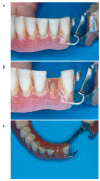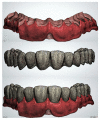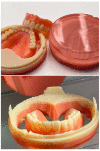Adhesion of Conventional, 3D-Printed and Milled Artificial Teeth to Resin Substrates for Complete Dentures: A Narrative Review
- PMID: 37299286
- PMCID: PMC10255431
- DOI: 10.3390/polym15112488
Adhesion of Conventional, 3D-Printed and Milled Artificial Teeth to Resin Substrates for Complete Dentures: A Narrative Review
Abstract
Background: One type of failure in complete or partial dentures is the detachment of resin teeth from denture base resin (DBR). This common complication is also observed in the new generation of digitally fabricated dentures. The purpose of this review was to provide an update on the adhesion of artificial teeth to denture resin substrates fabricated by conventional and digital methods.
Methods: A search strategy was applied to retrieve relevant studies in PubMed and Scopus.
Results: Chemical (monomers, ethyl acetone, conditioning liquids, adhesive agents, etc.) and mechanical (grinding, laser, sandblasting, etc.) treatments are commonly used by technicians to improve denture teeth retention with controversial benefits. Better performance in conventional dentures is realized for certain combinations of DBR materials and denture teeth after mechanical or chemical treatment.
Conclusions: The incompatibility of certain materials and lack of copolymerization are the main reasons for failure. Due to the emerging field of new techniques for denture fabrication, different materials have been developed, and further research is needed to elaborate the best combination of teeth and DBRs. Lower bond strength and suboptimal failure modes have been related to 3D-printed combinations of teeth and DBRs, while milled and conventional combinations seem to be a safer choice until further improvements in printing technologies are developed.
Keywords: 3D-prinitng; CAD/CAM; acrylic denture teeth; adhesion; complete dentures; milling.
Conflict of interest statement
The authors declare no conflict of interest.
Figures





Similar articles
-
Bonding Efficiency between Artificial Teeth and Denture Base in CAD/CAM and Conventional Complete Removable Dentures.Materials (Basel). 2024 Jun 27;17(13):3138. doi: 10.3390/ma17133138. Materials (Basel). 2024. PMID: 38998221 Free PMC article. Review.
-
Bond Strength of Denture Teeth to Heat-Cured, CAD/CAM and 3D Printed Denture Acrylics.J Prosthodont. 2020 Jun;29(5):415-421. doi: 10.1111/jopr.13125. Epub 2019 Nov 19. J Prosthodont. 2020. PMID: 31697004
-
Stainability of acrylic resin materials used in CAD-CAM and conventional complete dentures.J Prosthet Dent. 2020 Jun;123(6):880-887. doi: 10.1016/j.prosdent.2019.07.004. Epub 2019 Nov 5. J Prosthet Dent. 2020. PMID: 31703924
-
Tendency of microbial adhesion to denture base resins: a systematic review.Front Oral Health. 2024 May 16;5:1375186. doi: 10.3389/froh.2024.1375186. eCollection 2024. Front Oral Health. 2024. PMID: 38817845 Free PMC article.
-
In Vitro Analysis of Shear Stress: CAD Milled vs Printed Denture Base Resins with Bonded Denture Tooth.J Prosthodont. 2023 Apr;32(S1):29-37. doi: 10.1111/jopr.13552. Epub 2022 Jun 27. J Prosthodont. 2023. PMID: 35674217
Cited by
-
Effect of Duplication Techniques on the Fitting Accuracy of CAD-CAM Milled, 3D-Printed, and Injection-Molded Mandibular Complete Denture Bases.Dent J (Basel). 2024 Feb 2;12(2):32. doi: 10.3390/dj12020032. Dent J (Basel). 2024. PMID: 38392236 Free PMC article.
-
In vitro bonding strength of denture teeth to denture base in CAD/CAM-milled, 3D-printed and conventional manufacturing processes.Clin Oral Investig. 2024 Dec 7;29(1):4. doi: 10.1007/s00784-024-06099-y. Clin Oral Investig. 2024. PMID: 39643786 Free PMC article.
-
The evaluation of shear bond strength of denture teeth to CAD/CAM dentures acrylic after aging in gastric acid.Heliyon. 2025 Jan 13;11(2):e41930. doi: 10.1016/j.heliyon.2025.e41930. eCollection 2025 Jan 30. Heliyon. 2025. PMID: 39897898 Free PMC article.
-
Exploring the Properties and Indications of Chairside CAD/CAM Materials in Restorative Dentistry.J Funct Biomater. 2025 Feb 1;16(2):46. doi: 10.3390/jfb16020046. J Funct Biomater. 2025. PMID: 39997580 Free PMC article. Review.
References
-
- Stierman B., Afful J., Carroll M.D., Chen T.C., Davy O., Fink S., Fryar C.D., Gu Q., Hales C.M., Hughes J.P., et al. National Health and Nutrition Examination Survey 2017–March 2020 Prepandemic Data Files-Development of Files and Prevalence Estimates for Selected Health Outcomes. National Health Statistics Reports. [(accessed on 13 February 2023)];2021 Available online: https://stacks.cdc.gov/view/cdc/106273.
-
- Zitzmann N.U., Scherrer S.S., Weiger R., Lang N.P., Walter C. Preferences of dental care providers in maintaining compromised teeth in relation to their professional status: Implants instead of periodontally involved maxillary molars? Clin. Oral Implants Res. 2011;22:143–150. doi: 10.1111/j.1600-0501.2010.02062.x. - DOI - PubMed
-
- Driscoll C.F., Freilich M.A., Guckes A.D., Knoernschild K.L., Mcgarry T.J., Goldstein G., Goodacre C., Guckes A., Mor S., Rosenstiel S., et al. The Glossary of Prosthodontic Terms. J. Prosthet. Dent. 2017;117:C1-e105. doi: 10.1016/j.prosdent.2016.12.001. - DOI
-
- Takahashi Y., Chai J., Takahashi T., Habu T. Bond strength of denture teeth to denture base resins. Int. J. Prosthodont. 2000;13:59–65. - PubMed
Publication types
LinkOut - more resources
Full Text Sources
Miscellaneous

